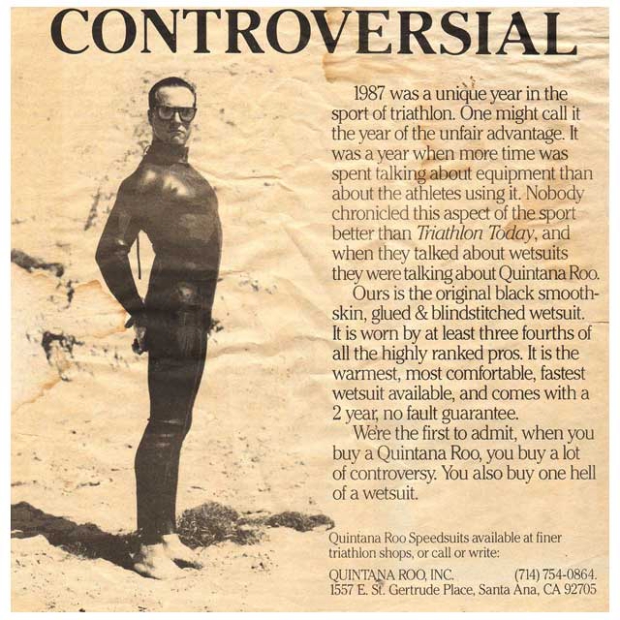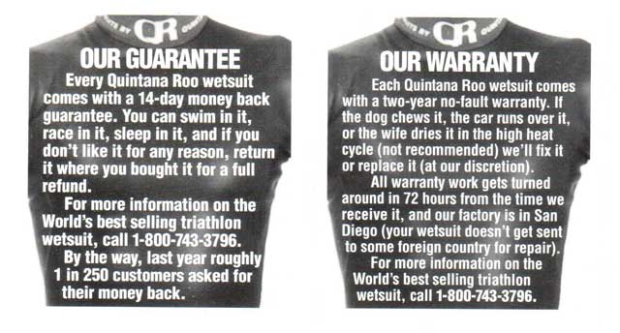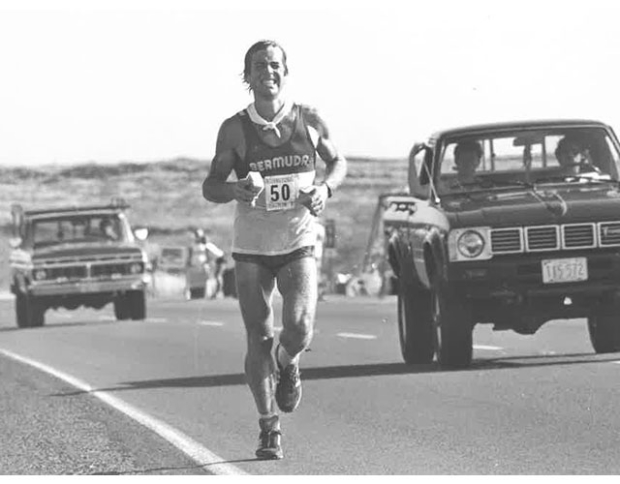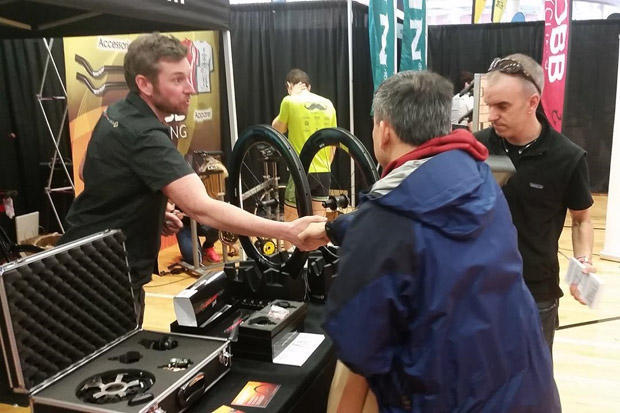Tenacity and Customer Service Can Take You Places
During my monthly junk divestiture – where I err on the side of dumping anything I didn’t have an immediate use for – I came upon some old stuff from the early QR days. Below is, as well as I can remember, the first ad we ever ran, and I ran this ad in Inside Triathlon, back when it was Lew Kidder’s publication.
Unless you were around then, you won’t remember how stark was the difference in tri before 1987 and after it. Prior to 1987 it was road bikes, road handlebars, and altogether just road race stuff used during the bike leg. When I raced the Hawaiian Ironman in 1981 the “helmet” I used was what was called a leather hairnet. I raced with clip-and-strap pedals. Few things changed between 1981 and 1986. We got aero wheels, hard shell helmets, clipless pedals and Oakley Factory Pilots. But it was still mostly road bikes ridden in our Speedos.

Until Scott DH Aerobars. That changed everything. And, the wetsuit. None of us wore wetsuits prior to 1987, except a few beach boys who’d wear their surf wetsuits during extremely cold swims. Still, I remember standing in snow in September of 1986 in the Sierra Nevada mountains in my Speedo getting ready for the swim start and thinking there must be a better way. Four months later I had that better way.
Just, if you read the ad (yes, that's Emilio De Soto starring!), you can see what it was like back then. A lot of people had a lot to say about both aerobars and wetsuits invading their sport. Nothing today rivals the aerobar and the wetsuit when it comes to “mandatory” tech, without which you couldn’t be competitive. I was happy having a contracting factory build my wetsuits (as is the case for virtually all wetsuit brands today). But I literally couldn’t get them built fast enough – not by a longshot. So I reluctantly bought a dozen sewing machines (on credit, as I had no money), and hired everybody I could find who’d previously been fired from the contracting factory then building my wetsuits. I got a job waiting tables at night so I could afford to buy rubber.
I ran my ads in Triathlon Today because Triathlete Magazine simply would not mention wetsuits. Would not mention them. Mind, by May of 1987, I had pictures of the start line of races where the entire pro field was wearing my wetsuits, while the entire age group field – save perhaps 1 or 2 – was in bare skin. Clearly something was happening, but that magazine refused to cover it. Finally, perhaps sometime in 1988, the magazine's editor, Terry Mulgannon, a terrific writer and editor, finally sat with me and chain smoked his way through an interview.

We moved forward, me knowing exactly zero about business. You’d laugh if I told you. Cringeworthy stories of my lack of acumen. (I wrote about the early days of wetsuit selling in The Transaction) But I had the tenacity of youth; and a sense of the reasonable expectations a customer should have, since I was fresh off of being simply a customer myself.
Hence our 2-year no-fault warranty, and our try-and-return guarantee, and this artwork you see above was for our hang tags. Boy did I get a lot of grief from both our retailers and from other wetsuit companies, who all told me I was ruining the industry. People will buy their wetsuits, use it for their races, and then return them! predicted my retailers. I had more faith. I was right. Our policy was the same, from my first day of business in 1987 until my last in 1999, and at our peak, when we were manufacturing and selling upwards of 15,000 wetsuits a year, I don’t remember ever absorbing more than about a dozen returned wetsuits in a year.
Now, about that no-fault warranty. Read the words above. This version of our hang tag artwork was from the mid-90s, and it wasn’t made up. We got a frantic call one day, in 1992 or 93, from a wife of a triathlete who’d returned home from a race, and she promptly threw the wetsuit into the clothes dryer. Out came a ball of plastic. Put it in a box and send it to us, we said, and the box we got was the size of a volleyball. No repairing that! We sent her a new suit, no charge.
Fast forward to 1998. I’d decided to resuscitate the old Bud Lite Triathlon Series, but without Bud Lite. I needed a big sponsor or no series. Long story short, I got that sponsor, paying us $750,000 over two years. When the deal was signed, in my office, I said to the EVP of Marketing of that company, “We’re not just a race organizer. We manufacture things. Bikes and wetsuits. Let’s walk out back and I’ll show you what we do.”
He said, “I know what you do. In fact, several years back my wife called you in a panic, because she’d put my wetsuit in the dryer…”
I entered business with no knowledge. I exited business – that chapter of my business life – with a set of axioms I’d developed, one of which is best explained by Steve Martin as Vincent Antonelli in My Blue Heaven: "It's not tipping I believe in. It's overtipping.” Accordingly, it’s not customer service I believe in. It’s beyond customer service which, as is demonstrated above, can come back to you in unexpected ways.




